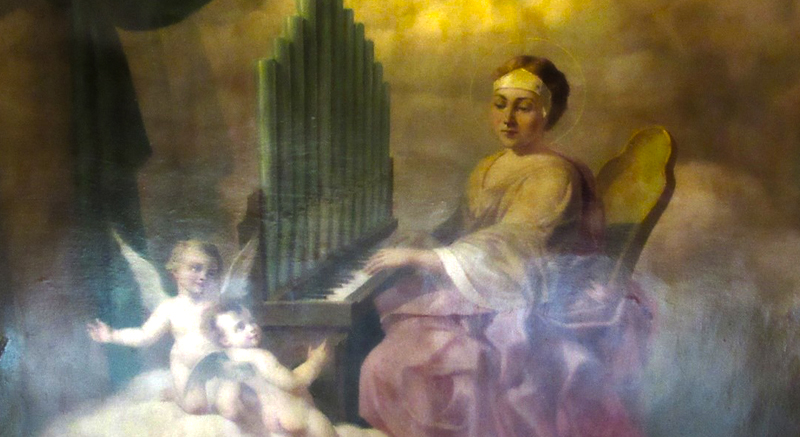(Martyred c. 230 Ad)
The picture of St. Cecelia above comes from the ceiling over the choir loft at St. Mary of Mount Carmel / Blessed Sacrament Parish.
Today we celebrate her feast. Her story is contained in the Passio Sanctae Caeciliae, a more literary than historical text. It tells us that Cecilia was betrothed to the Roman patrician, Valerian. On their wedding day, she revealed that she had converted to Christianity and vowed perpetual virginity. Valerian then agreed to be catechized and baptized secretly by Pope Urban I.
Shortly afterward, Valerian’s brother Tiburtius embraced the Christian faith. The two brothers were soon arrested by order of the Prefect, Turcius Almachius. After being tortured, they were decapitated with Maximus, the officer who had the task of bringing them to jail, and who, along the way, had himself converted.
Almachius then decided to kill Cecilia but feared the repercussions of a public execution given the popularity of the young Christian. After her summary judgment, orders were given that she return home to be locked in the steam room (which was to be brought to extremely high temperature), thus staging a death by asphyxiation.
After one day and one night, the guards found Cecilia miraculously alive. Almachius then ordered her decapitation, but despite the three violent blows to the neck, the executioner could not sever Cecilia’s head. Cecilia died after three days of agony, during which she gave all her belongings to the poor, her home to the Church — and, no longer able to speak, continued to profess her faith in the Triune God, by using her fingers: raising the thumb, forefinger and middle finger of her right hand (to indicate three Divine Persons) and the index of her left hand (to indicate the one Divine Nature).
On the eve of the Jubilee of 1600, during the Basilica’s restoration by Cardinal Paolo Emilio Sfrondati, the sarcophagus containing the body of the young saint — in a marvelously great state of preservation — was found, with the body wrapped in a silk and gold dress.
The link between the saint and music comes down to us from the Middle Ages. Some say it was the result of an error in the translation of the Passio. Others say it came from the entrance antiphon on the Mass of her feast day, which reads, “While the organs played, she sang in her heart only to the Lord.”
Cecilia is usually portrayed in art with an organ and other instruments. One of the finest music conservatories in Italy is in Rome and called “L’Accademia di Santa Cecilia.”
Adapted by A.J. Valentini
